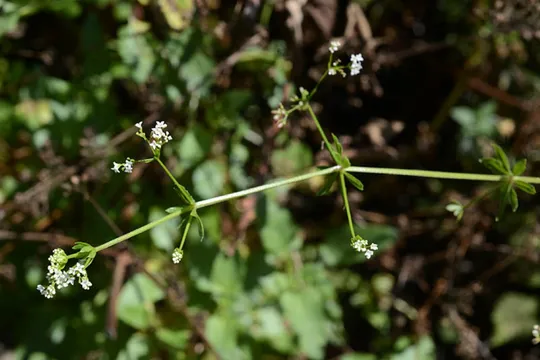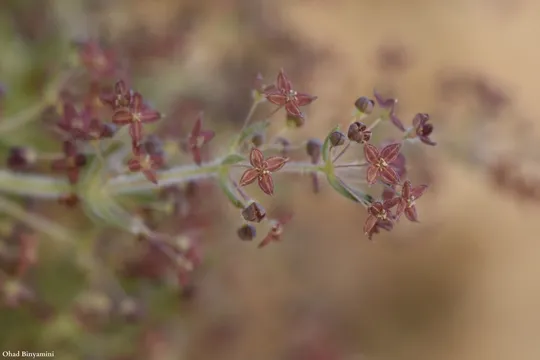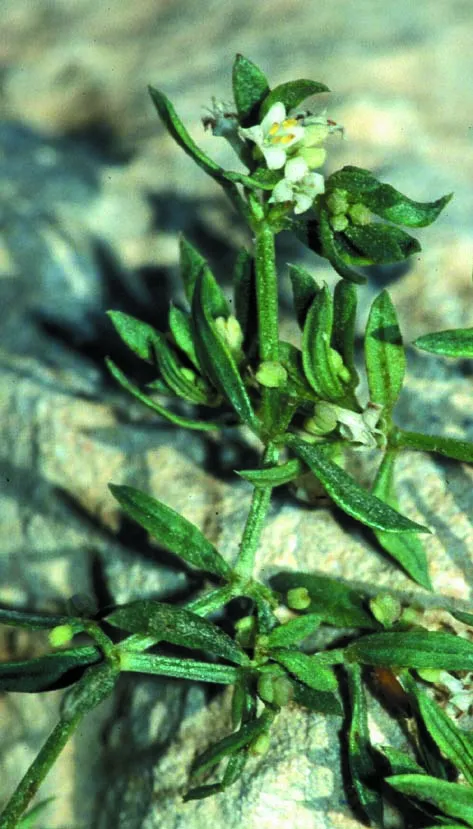River Bedstraw
Galium rivale

Galium rivale grows in two
adjacent regions – the Hula Valley and the adjacent Golan
Heights slopes: in the Hula Valley it grows on more than ten sites concentrated in two sections: the Banias-Tel Dan Reserve-Senir (Hatsbani Stream) section and the Gonen-En Divsha-Gilbon Stream section. It was also found
at En Brakha (1991). According to the herbarium sheets it appears G.rivale
was once much more common in the Hula Valley. In
the Golan it
grew in streams with abundant water
that descended to the Hula and to the Bet Tsayda valleys –
the Gilbon, Zavitan, Samakh and El Al streams. In these streams it is very rare, and only a few individuals
were observed. Interestingly, the species was not collected in the Bet Tsayda Valley itself!
G. rivale was collected twice in the Bet She’an Valley, near Kfar Ruppin and Tirat Tsvi in 1964-1976. All our attempts to find the species in the Bet She’an Valley were unsuccessful, leading us to believe that the species is extinct in this area. G. rivale was collected twice on
Mt. Hermon on the hill overlooking the Banias and in Wadi Govta at an altitude of 600 meters.
Hedges at the edge of springs
and riverbanks.
The
genus Galium has 300 species of herbaceous plants with a square stem,
found in all the continents of the world, concentrated mainly in temperate
areas: in Europe (141 species) and in the
Mediterranean Basin. Turkey has the greatest number of Galium
species – 101 species.
G. rivale belongs
to the group of perennial Galium, whose flowers are white with
a short corolla tube (i.e. the corolla is bell shaped not
wheel-shaped as in the other Galium) species. In Israel, the following species
belong to this group: G.
humifusum and G. incanum hat
grow in the tragacanth zone on Mt. Hermon. G. humifusum is close to G.
rivale both morphologically and regarding its habitat. According to the
Flora Palaestina G. rivale has a white corolla and its lobes are not
pointed, whereas in G. humifusum the corolla is pale yellow and its
lobes end in a long point. In G. humifusum
the flowers blacken once dry, while in G. rivale they remain green. Also only in G. humifusum are the leaves slightly reflexed. The inflorescence of G. rivale is
more spacious and less dense than that of G. humifusum.
·
Galium
rivale once grew
in at least 30 sites, of which today only 21 are known. The number of regions decreased from three, fifty years ago, to two today.
·
Most
of sites are within the nature reserves of
the Hula Valley and the Golan Heights; however
botanists and rangers have the impression that the species has
become very rare in both regions, for reasons
that are not clear.
·
The
habitat of G. rivale is constantly threatened because
of the significant reduction in the amount of flowing water
and stream desiccation.
·
G.
rivale is apparently not globally endangered.
A detailed survey should
be conducted in the Hula Valley to map
the growth sites of Galium rivale and to estimate
the size of the populations.It
should determine whether G. rivale and
G. elongatum grow in the area
and what is the relation between them
and G. humifusum. Two populations should be monitored, one
in the Tel Dan Reserve and the other at
En Divsha.
Galium rivale has a broad distribution. It grows throughout southern and
Western Europe (including all the northern Mediterranean
countries), Turkey, Caucasia, Iran, Central Asia and western Siberia. It has also been described from Greece.
Galium rivale entwines itself and climbs
on stream bank vegetation and marsh thicket plants. It is very rare, peripheral
and grows only in the Hula Valley. G.
rivale is extinct from the remaining regions in which
it once grew. Wetlands, its habitat, are continually being destroyed
and drained. G.rivale is an excellent example
of a northern Euro-Siberian plant whose southernmost global distribution limit
is in Israel; its populations are quickly becoming extinct primarily due to
habitat destruction.
Current Occupancy Map
| 1000 squre meter pixel | 5000 squre meter pixel | 10000 squre meter pixel | |
|---|---|---|---|
| number of observations | 0 | 0 | 0 |
| in total pixels | 0 | 0 | 0 |
| Family | Rubiaceae |
| Classification | On the endangered species list |
| Ecosystem | Mediterranean humid |
| Chorotype | Euro- Siberian |
| Conservation Site | Tel Dan Reserves and En Divsha |
| Rarity |
1
2
6
|
|---|---|
| Vulnerability |
0
3
4
|
| Attractiveness |
0
0
4
|
| Endemism |
0
0
4
|
| Red number |
1
3.2
10
|
| Peripherality | N |
| IUCN category | DD EW EX LC CR EN VU NT |
| Threat Definition according to the red book | Vulnerable |
 Based on:
Based on:






